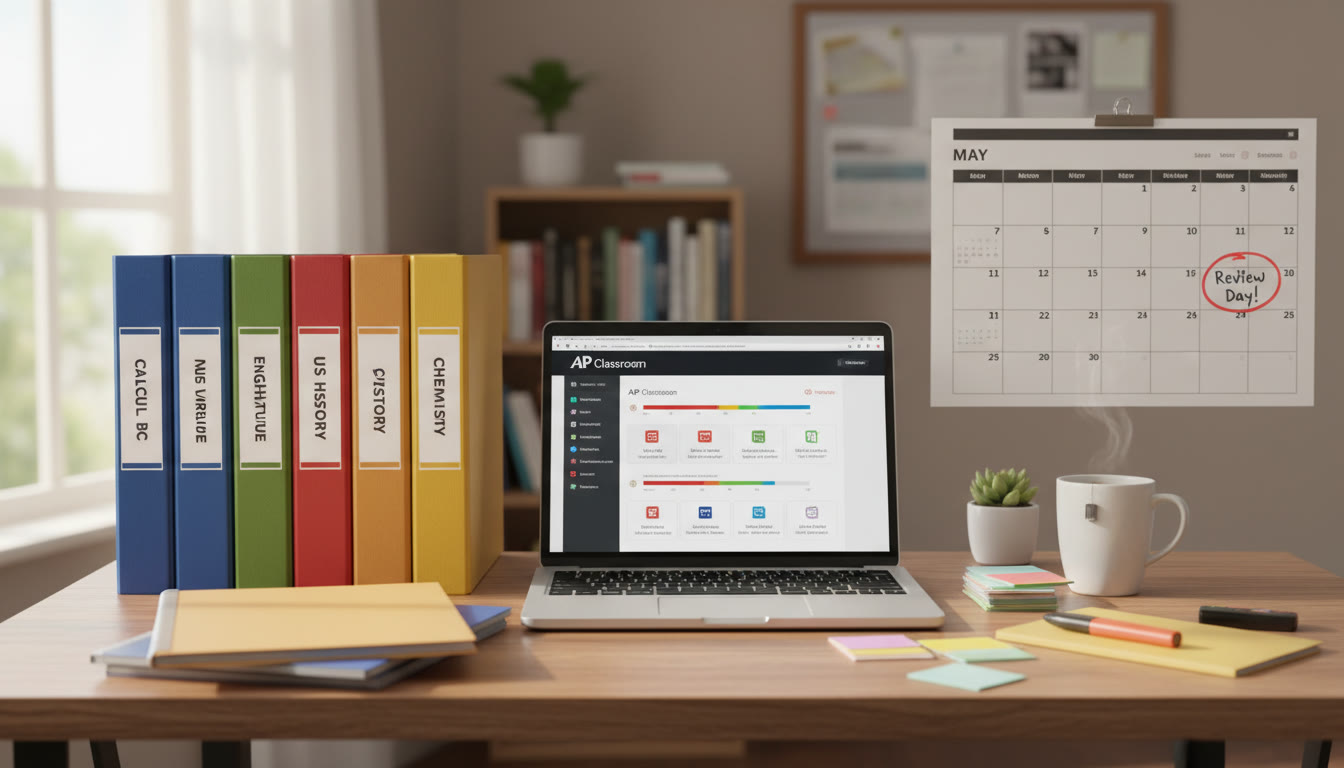Why a Monthly AP Review Day Works
Imagine if one well-planned day each month could dramatically reduce last-minute panic, sharpen the skills you actually need on test day, and keep you steadily moving toward that 4 or 5. That’s the idea behind a Monthly AP Review Day: a dedicated, intentional block of time—ideally 3–6 hours—where you step back from daily homework and focus on consolidation, practice, reflection, and planning.
Monthly review days work because they create rhythm. Instead of reacting to the next quiz or homework deadline, you build a recurring checkpoint. Over a school year, these checkpoints transform fragmented studying into a coherent, cumulative approach: gaps become visible and fixable, timing strategies get practiced, and confidence grows.

Who this system is for
- Students juggling multiple AP courses who need an efficient, repeatable plan.
- Self-studiers who want structure without a full course schedule.
- Students aiming to convert effort into measurable score improvement.
- Anyone who wants to replace chaotic cram sessions with calm, evidence-based work.
How to Schedule Your Monthly AP Review Day
Choose one day each month—weekends usually work best—and block 3 to 6 hours. The length depends on how many APs you’re taking and how far you are from exam day. If you have several APs, consider alternating heavier focus between subjects across months (e.g., May: Physics + Calculus; June: English + US History).
Key timing tips:
- Place your Review Day within the first week of each month so you can adjust month-long study goals based on findings.
- If your exams are within six weeks, increase to biweekly review days for the most critical subjects.
- Keep the environment consistent—a quiet library room, a study café, or a designated spot at home—to train your brain to focus faster.
Monthly AP Review Day: The System
This is a practical, hour-by-hour template you can adapt. The structure balances active practice, targeted review, reflection, and planning so each session leaves you with clear next steps rather than just a fog of “I studied a lot.”
Overview Template (4–5 hours)
- 0:00–0:15 — Warm-up and Goal Setting
- 0:15–1:30 — Focused Practice Block 1 (Past-Free Response or MC set)
- 1:30–1:45 — Short Break and Reflection
- 1:45–3:00 — Focused Practice Block 2 (Timed Practice or Problem Set)
- 3:00–3:20 — Deep Review (Scoring, Targeted Rewrites)
- 3:20–3:40 — Strategy Session (Timing, Calculator Use, Essay Outlines)
- 3:40–4:00 — Plan the Month: Tasks, Mini-Deadlines, and Checkpoints
Detailed Breakdown
0:00–0:15 — Warm-up and Goal Setting
- Quick diagnostic: one mixed question set (10–15 questions) to identify weak areas.
- Write 2–3 concrete goals for the day (e.g., “Master FRQ score rubric for Question 2”, “Finish two timed 25-question MC sets”).
0:15–1:30 — Focused Practice Block 1
- Work on the most score-sensitive tasks first: free-response prompts, past long-form questions, or full practice set segments.
- Use official College Board FRQs or AP Classroom progress checks when possible to mirror the real exam format.
1:30–1:45 — Short Break and Reflection
- Stand up, hydrate, and jot down what felt hard, what took too long, and what you guessed on.
1:45–3:00 — Focused Practice Block 2
- Timed multiple-choice practice or problem-solving under simulated conditions (no notes, strict timing).
- If you take a calculator-permitted exam, practice exact calculator skills and shortcuts in this block.
3:00–3:20 — Deep Review
- Score your practice honestly. For essays, either self-score using the rubric or swap with a study partner for feedback.
- Create a “Mistake Map”: list errors, categorize them (content, timing, reading, careless), and write one action to fix each type.
3:20–3:40 — Strategy Session
- Build or refine templates (for essays, problem-solving steps, or experiment write-ups).
- Practice pacing strategies—when to skip, how long to linger, and when to guess.
3:40–4:00 — Plan the Month
- Create a weekly micro-plan with 3–4 specific tasks informed by today’s Mistake Map.
- Set one checkpoint for mid-month (a 45–60 minute mixed practice) and schedule the next Monthly Review Day.
Printable Monthly Checklist (Use This During Your Review Day)
| Section | Task | Completed | Notes |
|---|---|---|---|
| Warm-up | 10–15 mixed diagnostic questions | [ ] | |
| Practice Block 1 | 1 FRQ or 25 MC (timed) | [ ] | |
| Practice Block 2 | 1 timed MC section or problem set | [ ] | |
| Deep Review | Score, create Mistake Map | [ ] | |
| Strategy | Refine templates and timing | [ ] | |
| Plan | Set weekly tasks and next Review Day | [ ] |
What to Do Between Review Days
Monthly Review Day is the engine; daily and weekly habits are the fuel. Use the month to chip away at the specific actions you identified. Keep tasks short and measurable.
- Weekly (2–3 sessions): 45–60 minutes focused on a single weak subtopic (e.g., light and optics, APUSH Reconstruction, poetry devices).
- Biweekly: a timed mixed practice of 30–45 minutes to maintain test stamina.
- Daily (15–25 minutes): flashcards for vocabulary, formulas, or quick concept checks.
Set reminders on your phone or planner for these micro-tasks and treat them as non-negotiable. Small, consistent practice defeats last-minute cramming every time.
How to Use Official College Board Resources Effectively
College Board provides AP Classroom, past free-response questions, and course descriptions—these are gold. Don’t just read the materials; turn them into practice and evidence-based improvements.
- AP Classroom: Use Topic Questions and Progress Checks to identify persistent weak spots. Assign one progress check before each Review Day and bring the results with you.
- Past FRQs: Treat them as real tests. Time them, score them with the official rubric, and rewrite weak responses.
- Course and Exam Description: Make sure every Monthly Review Day maps to the skills and common question formats listed here.
Real Examples: How Students Turned Review Days Into Gains
Case 1: Maya, AP Biology—She used Monthly Review Day to practice long-form FRQs and create an experiment-response template. By month three she cut the time needed to craft a complete experimental-methods response from 25 minutes to 14 minutes, and her FRQ rubric scores rose consistently.
Case 2: Jamal, AP US History—He used the Mistake Map to track misread questions and weak evidence integration. Each month he focused on writing one DBQ and one LEQ, practicing thesis construction and contextualization. His essays became clearer and faster; he reported feeling calmer entering the exam.
How to Score and Track Progress Over Time
Keep a simple score log—after each Review Day record: practice type, score/time, top 3 mistakes, and target action items. After 3 months, look for trends. Are multiple subjects showing the same issue (e.g., time management)? If so, prioritize that skill in the next cycle.
Sample Progress Tracker Table
| Date | Subject | Activity | Score/Time | Top Mistakes | Next Steps |
|---|---|---|---|---|---|
| Sep 6, 2025 | AP Chemistry | Timed MC 40 Q | 68% in 45 min | Stoichiometry setup, units | Daily 10-min stoich practice; next Review Day FRQ |
| Oct 4, 2025 | AP English Lang | 2 practice essays | 6/9 and 5/9 rubrics | Thesis clarity, evidence integration | Template practice; 1-on-1 essay review |
How Personalized Tutoring Can Fit Naturally Into Your Review Day
Monthly Review Day isn’t about doing everything alone. If you have access to a tutor, a portion of your Review Day can be dedicated to targeted, high-value feedback. For example, spend the Deep Review block doing live scoring and feedback with a tutor or saving one practice FRQ to be reviewed together.
Personalized tutoring—like Sparkl’s 1-on-1 guidance—can make these review days far more efficient: tutors zero in on rubric expectations, offer tailored study plans for the month, and provide AI-driven insights that highlight which skills will most likely improve your score. Use tutoring sessions for the hardest, highest-return tasks (essay scoring, difficult problem walkthroughs, timing strategies).
Common Pitfalls and How to Avoid Them
- Avoid passive reading: Highlighting notes without active testing is the single biggest time sink. Use practice questions or explain concepts aloud instead.
- Don’t overpack the day: Quality over quantity. Better to deeply review two mistakes than superficially touch ten topics.
- Don’t ignore logistics: For digital exams, practice on the Bluebook interface and confirm your device compatibility ahead of time.
- Steer clear of perfectionism: If you miss a concept, build a tiny habit—10–15 minutes daily—rather than trying to master it in one marathon session.
Month-by-Month Roadmap (From Now to Exam Day)
Below is a general roadmap that you can adapt depending on how many months you have left before exam day. The idea is to move from breadth to depth, and from untimed understanding to timed mastery.
- Months 6+ out: Broad content coverage, vocabulary and formula drills, foundational FRQ structure practice.
- Months 3–5 out: Increase timed practice, simulate test sections, refine templates and pacing.
- Months 1–2 out: Full timed practice exams under test-like conditions, targeted tutoring sessions, final rubric polishing.
One-Week Checklist Leading to a Review Day
- Pick the Review Day and block the calendar.
- Gather materials: past FRQs, AP Classroom progress checks, calculator, scratch paper.
- Assign a pre-Review Day diagnostic (30 minutes) to decide priority topics.
- If using a tutor, book a 60–90 minute slot immediately after the Review Day for feedback.

Final Notes: Make It Yours
Monthly AP Review Day is a framework, not a rulebook. The secret is consistency plus smart reflection. Use the Mistake Map honestly, lean on official College Board materials for authentic practice, and let tutoring amplify your highest-leverage improvements. If Sparkl’s personalized tutoring fits your budget and schedule, a few well-timed 1-on-1 sessions can speed up the feedback loop so that your Monthly Review Days become increasingly effective.
Start small: schedule one Review Day next month, use the printable checklist, and see how much more direction you feel after a single session. Most students notice calmer pacing, clearer priorities, and—most importantly—steady improvement on practice scores. That’s the power of one intentional day every month.
Quick Action Steps (Do This Now)
- Pick a Review Day date for next month and block 3–5 hours.
- Download or gather one official FRQ and one timed MC set for that day.
- Create your first Mistake Map and set three measurable weekly tasks for the month.
- Consider booking a targeted Sparkl session for focused feedback after your Review Day.
Closing Encouragement
Your AP journey is a marathon with many checkpoints. Monthly AP Review Day is a small, repeatable checkpoint that keeps momentum, keeps mistakes visible, and turns anxiety into a plan. Do it consistently, reflect honestly, and seek help when a problem persists. You’ll be surprised how quickly steady, deliberate work translates into both higher scores and quieter nerves on exam day.
Go schedule that first Review Day—you’re closer than you think.





















No Comments
Leave a comment Cancel